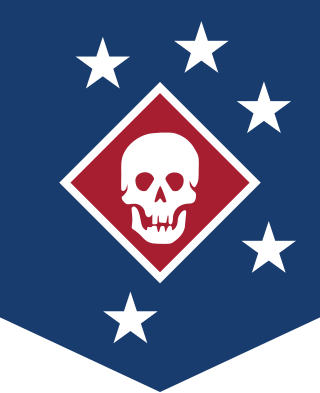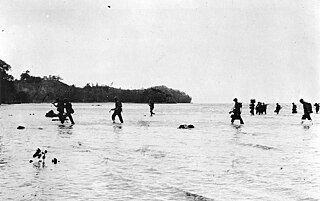
The Guadalcanal campaign, also known as the Battle of Guadalcanal and codenamed Operation Watchtower by American forces, was a military campaign fought between 7 August 1942 and 9 February 1943 on and around the island of Guadalcanal in the Pacific theater of World War II. It was the first major land offensive by Allied forces against the Empire of Japan.

The Marine Raiders are special operations forces originally established by the United States Marine Corps during World War II to conduct amphibious light infantry warfare. "Edson's" Raiders of 1st Marine Raider Battalion and "Carlson's" Raiders of 2nd Marine Raider Battalion are said to have been the first United States special operations forces to form and see combat during World War II.

Michael Strank was a United States Marine Corps sergeant who was killed in action during the Battle of Iwo Jima in World War II. He was one of the Marines who raised the second U.S. flag on Mount Suribachi on February 23, 1945, as shown in the iconic photograph Raising the Flag on Iwo Jima by photographer Joe Rosenthal. Of the six Marines depicted in the photo, Strank was the only one to be correctly identified from the beginning; the other five were either assigned the wrong locations, or, were given the names of Marines who were not in the photo.

Merritt Austin Edson, Sr., known as "Red Mike", was a Major General in the United States Marine Corps, First President of the Marine Corps War Memorial Foundation and First Commissioner of the Vermont Department of Public Safety & Vermont State Police.

The Paramarines was a short-lived specialized combat unit of the United States Marine Corps, trained to be paratroopers dropped from planes by parachute. Marine parachute training which began in New Jersey in October 1940 ended with the parachute units being disbanded at Camp Pendleton, California in February 1944. Paratroopers received a significantly increased salary after completing training, so there was no shortage of volunteers, although all were required to be unmarried. Standards of fitness were high, and 40% failed the training course.
Willard Woodward Keith, Jr. was a United States Marine Corps infantry officer who was posthumously awarded the Navy Cross for his heroic leadership during World War II in the Matanikau Offensive of the Guadalcanal Campaign. Two cancelled United States Navy destroyer escorts and the destroyer USS Willard Keith (DD-775) were named in his honor.

Charles Joseph Berry was a Corporal in the Marine Corps who posthumously received the Medal of Honor for his actions during World War II.

Evans Fordyce Carlson was a decorated and retired United States Marine Corps general officer who was the leader of "Carlson's Raiders" during World War II. Many credit Carlson with developing the tactics and attitude that would later come to define America's special operations forces. He is renowned for the "Makin Island raid" in 1942, and his raiders' "Long Patrol" behind Japanese lines on Guadalcanal, in which 488 Japanese were killed. Carlson popularized the phrase "gung-ho".

The Battle of Edson's Ridge, also known as the Battle of the Bloody Ridge, Battle of Raiders Ridge, and Battle of the Ridge, was a land battle of the Pacific campaign of World War II between Imperial Japanese Army and Allied ground forces. It took place from 12–14 September 1942, on Guadalcanal in the Solomon Islands, and was the second of three separate major Japanese ground offensives during the Guadalcanal campaign.

The Battle of Tulagi and Gavutu–Tanambogo was a land battle of the Pacific campaign of World War II, between the forces of the Imperial Japanese Navy and Allied ground forces. It took place 7–9 August 1942 on the Solomon Islands, during the initial Allied landings in the Guadalcanal campaign.

The Actions along the Matanikau—sometimes referred to as the Second and Third Battles of the Matanikau—were two separate but related engagements between the United States and Imperial Japanese naval and ground forces in the Pacific theater of World War II. The actions occurred around the Matanikau River on Guadalcanal Island in the southwestern Pacific during the Guadalcanal campaign. These particular engagements—the first taking place between 23 and 27 September, and the second between 6 and 9 October—were two of the largest and most significant of the Matanikau actions.

The Kawaguchi Detachment was an Imperial Japanese Army brigade that existed during World War II. Under the command of Major General Kiyotake Kawaguchi, they fought in the Battle of Borneo and a part of the Guadalcanal Campaign. After October 1942, they had a different commander.

Samuel Blair Griffith II was a brigadier general in the United States Marine Corps. Griffith entered the Marines in 1929 after graduating from the United States Naval Academy. He served in and commanded Marine units in the Pacific theater of World War II and retired from service in 1956. After his retirement, Griffith wrote several books and numerous articles on military history and lectured widely. He died on March 27, 1983, in Rhode Island.

The Landings at Cape Torokina, also known as Operation Cherryblossom, took place at the beginning of the Bougainville campaign in World War II. The amphibious landings were carried out by elements of the United States Marine Corps in November 1943 on Bougainville Island in the South Pacific, as part of Allied efforts to advance towards the main Japanese base around Rabaul under Operation Cartwheel. Coming in the wake of Allied successes at Guadalcanal and in the central Solomons, the landings were intended to secure a beachhead with the purpose of establishing several bases from which to project air and naval power closer towards Rabaul, in an effort to neutralize the large Japanese force that had been established there.

Carlson's patrol, also known as The Long Patrol or Carlson's long patrol, was an operation by the 2nd Marine Raider Battalion under the command of Evans Carlson during the Guadalcanal campaign against the Imperial Japanese Army from 6 November to 4 December 1942. In the operation, the 2nd Raiders attacked forces under the command of Toshinari Shōji, which were escaping from an attempted encirclement in the Koli Point area on Guadalcanal and attempting to rejoin other Japanese army units on the opposite side of the U.S. Lunga perimeter.

The Battle of Bairoko was fought between American and Imperial Japanese Army and Navy forces on 20 July 1943 on the northern coast of New Georgia Island. Taking place during World War II, it formed part of the New Georgia campaign of the Pacific War. In the battle, two battalions of the US Marine Raiders from the 1st Marine Raider Regiment, supported by two US Army infantry battalions, attacked a Japanese garrison guarding the port of Bairoko on the Dragons Peninsula, advancing from Enogai and Triri. After a day long engagement, the Japanese repulsed the American assault and forced the attacking troops to withdraw with their wounded to Enogai. US forces remained in the area carrying out patrolling and intelligence gathering operations until the end of the campaign. Bairoko was eventually captured at the end of August after the airfield at Munda had been captured, and further reinforcements were sent from there towards Bairoko to clear the area from the south.
The United States Marine Corps Scout and Sniper companies and the Scouts (Tank) companies of the tank battalions were the first among the division's reconnaissance assets. They existed around the same exact moment when 1st and 2nd Marine Division were created. In 1941, each regiment had a scout and sniper platoon. They were assigned to the regimental Headquarters and Service Company. These companies were used in variety of tasks and, on occasion in severe combat, were used as "spare" rifle companies. When 6th Marine Division deactivated after the end of World War II, its recon assets also deactivated. Only the current Marine Division Recon Battalions that exist today hold history reference to the Scout and Sniper Companies.

Edwin Bliss Wheeler was a highly decorated officer of the United States Marine Corps with the rank of major general. He served with famous Marine Raiders during World War II and earned the Silver Star for gallantry in action. Wheeler served two tours of duty in Vietnam, as commanding officer of 3rd Marine Regiment in 1964–1965 and later as commanding general of 1st Marine Division in 1969–1970.
Robert Hugh Williams was a highly decorated United States Marine Corps brigadier general. He was one of the first Paramarine officers and was awarded the Navy Cross during the battle of Gavutu.
Dave Elliott Severance was a United States Marine Corps colonel. During World War II, he served as the commanding officer of Easy Company, 2nd Battalion, 28th Marines and led his company in the battle of Iwo Jima. During the battle, Severance ordered his 3rd Platoon to scale Mount Suribachi and raise the flag at the summit.
















